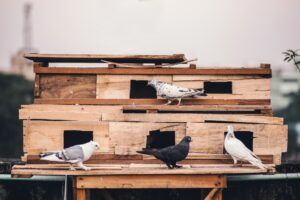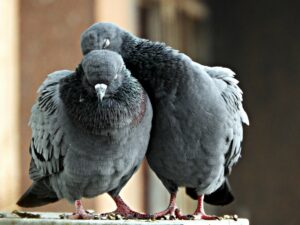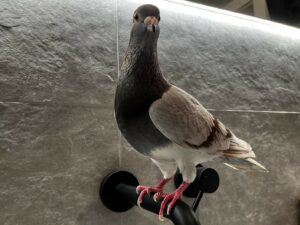Today, let’s talk about a bird that you might have seen in parks, cities, or maybe even near your home. Yes, we’re talking about pigeons! Pigeons are fascinating birds that live all around the world, and you can find them in both bustling cities and quiet countrysides. With their plump bodies, small heads, and flappy wings, pigeons have become a common sight for many of us. But have you ever stopped to really look at them and wonder about their lives? In this article, we’re going to explore what pigeons look like, how they behave, and why they are so special. So, join us on this exciting journey to get to know these friendly, feathery neighbors a bit better. Whether you’re a curious kid or an intrigued adult, there’s always something new to learn about pigeons!
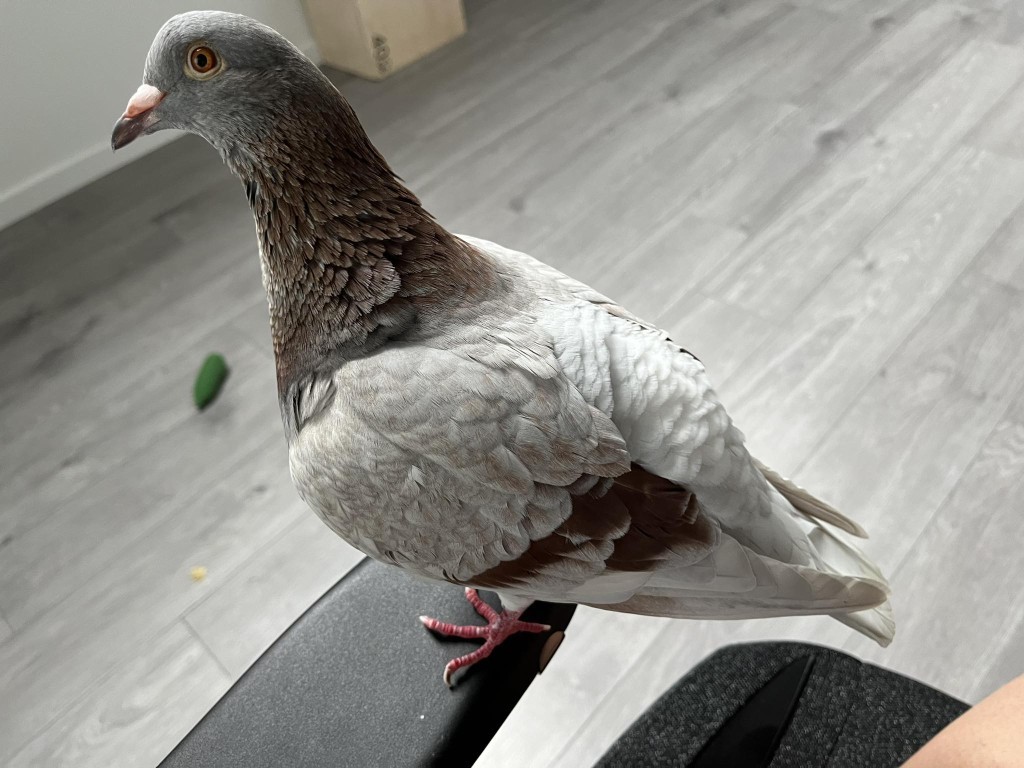
What Does a Pigeon Look Like?
What Does a Pigeon Look Like? Physical Appearance of Pigeons
Embarking on a journey through the enigmatic world of pigeons reveals a spectacle of diversity in their physical appearance. From the bustling city streets to serene countrysides, pigeons showcase an astonishing array of colors, sizes, and feather arrangements. Despite their common presence in our environments, there is a captivating variety among pigeon species that often goes unnoticed. This section will delve into the intriguing physical characteristics of these ubiquitous birds, exploring their distinctive plumage, stout bodies, and notable features that have allowed them to adapt and thrive in multifarious habitats around the globe.
Size and Shape
- General Body Size and Shape Pigeons are medium-sized birds with a rounded body. They are not too big or too small, just a comfortable size that fits nicely in our sight when we see them in parks or cities. Their bodies are a bit plump, and they have short legs that go tip-tap as they walk around.
- Beak, Head, and Neck Description Their beaks are not too long and have a little curve at the end. Pigeons have small heads that move in a cute, bobbing way when they walk. Their necks, which might seem short, can stretch out when they’re looking around or trying to peck at their food.
Color and Patterns
- Common Colors of Pigeons Pigeons come in many colors! Some are grey, while others might be brown or white. Sometimes, when the sun shines on their feathers, you might even see beautiful shiny colors like green or purple!
- Patterns on their Feathers and Variations If you look closely, pigeons can have various patterns on their feathers. Some have stripes, some have spots, and others might have a mix of colors. Each pigeon is unique, making them all the more interesting to observe.
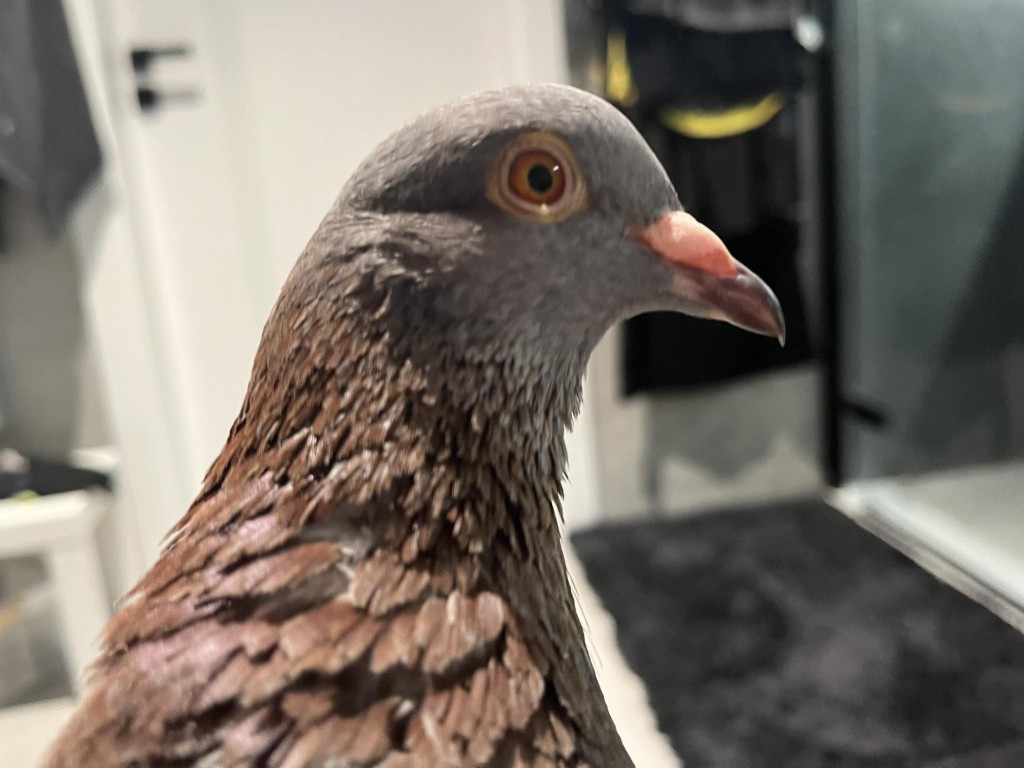
Wings and Flight
- Wing Shape and Size Pigeons have strong, wide wings that help them fly high and far. When they spread their wings, it’s like they have a mini cloak that helps them soar through the sky with ease.
- Flight Patterns and Abilities Watch pigeons as they fly; they can zoom straight across the sky or make fun turns and loops! Pigeons are fantastic fliers and can travel very long distances without getting too tired.
Eyes and Vision
- Eye Color and Size Pigeons have pretty, round eyes that can be various colors like orange, yellow, or even a cool red. Their eyes are always watching and observing what’s happening around them.
- Vision Capabilities and Interesting Facts Did you know pigeons have excellent vision? They can see things far away and even have a kind of “built-in GPS” that helps them find their way home, even from very far away! Pigeons are known for their remarkable ability to return to their homes over long distances, which is quite an exciting and fascinating fact!
Isn’t it amazing how there’s so much to learn about these seemingly simple city birds? Let’s continue to dive deeper and learn even more in the next sections!
Check my article about What Does A Baby Pigeon Look Like?
Pigeon Behavior and Personality
Pigeons, often encountered in urban landscapes and cherished in various cultures, exhibit a plethora of intriguing behaviors and distinct personalities that continue to fascinate bird enthusiasts and researchers alike. Delving into the world of pigeon behavior and personality reveals a spectrum of complex social structures, remarkable intelligence, and nuanced interactions that go far beyond our daily observations of them in parks and cities. Exploring these dynamics not only enriches our understanding of these often-underestimated creatures but also brings to light the symbiotic relationship pigeons have maintained with humans throughout history. Join us as we embark on a journey into the captivating realm of pigeon behavior, unearthing the hidden facets of their daily lives, intricate communication methods, and varied personalities.
Daily Activities
Eating Habits and Favorite Foods Pigeons are not very picky eaters. They enjoy pecking at seeds, fruits, and sometimes even little insects. When pigeons are in the city, they might also nibble on food that people share with them, like bread or popcorn. But it’s always best for pigeons to eat their natural foods to stay happy and healthy!
Resting and Sleeping Patterns Pigeons need their rest too! During the day, they might take short naps in safe spots like tree branches or building ledges. And when the sun sets, pigeons like to find a cozy place to sleep all night, away from the hustle and bustle.
Check my article about What Do Pigeons Eat?
Social Behavior
Interaction with Other Pigeons Pigeons are friendly birds and enjoy spending time together. They often form groups, called flocks, and you’ll see them flying, eating, or just hanging out with their pigeon pals. They like to be in company and share their day with others.
Pigeon’s Cooing and Communication Have you heard pigeons making soft, cooing sounds? That’s their way of talking to each other! Pigeons communicate by making various sounds and using body language, like fluffing their feathers or bobbing their heads, to express their feelings and messages to one another.
Check my article about What Does A Pigeon Sound Like?
Nesting and Raising Young
- How and Where They Build Nests Pigeons build nests to keep their eggs and babies safe. They usually find a spot that’s high up and away from danger, like in the ledges of buildings, on window sills, or in tree branches. They gather sticks, leaves, and other materials to create a comfy home for their little ones.
- Care and Growth of Pigeon Chicks Pigeon parents are very caring! Mom and Dad pigeons take turns keeping the eggs warm until they hatch. When the adorable, fluffy chicks (also called squabs) come out, the parents feed them a special “pigeon milk” and keep them safe. As the days go by, the chicks grow bigger, learn to fly, and soon, they’re ready to explore the world on their own!
Isn’t the life of a pigeon intriguing? Who knew our feathery neighbors had such interesting lives! Let’s keep learning and exploring more pigeon wonders in the following sections.
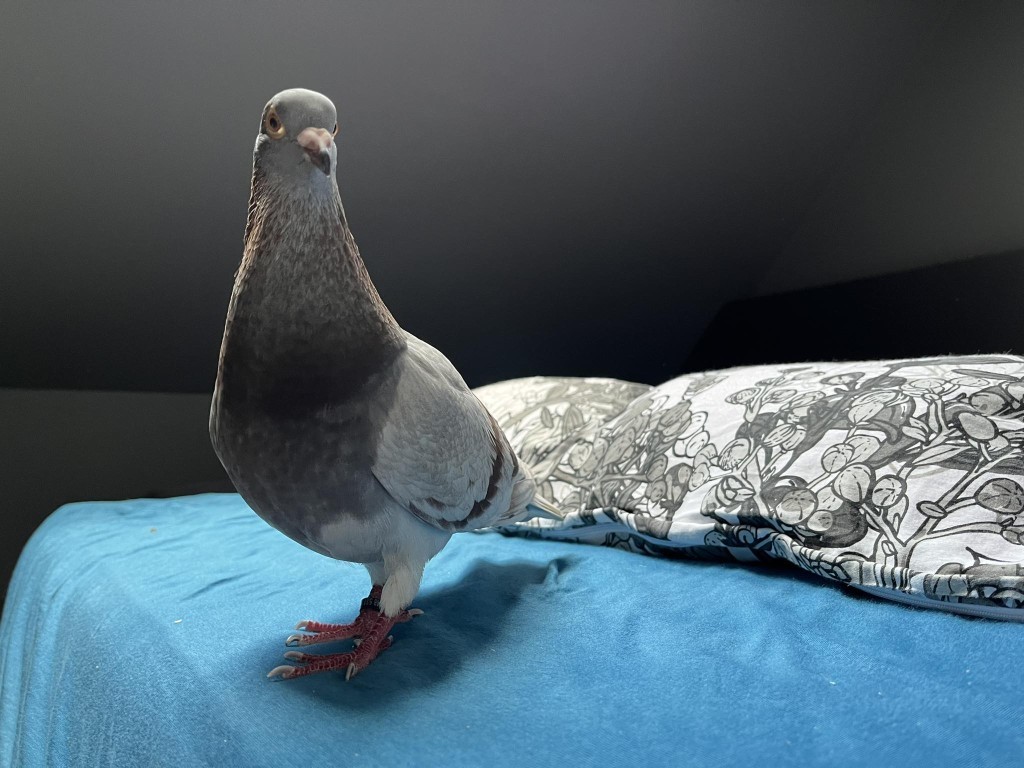
Different Types of Pigeons
Venturing into the diverse and fascinating world of pigeons unfolds a panorama of unexpected variety and beauty. From the bustling urban squares to serene countryside, pigeons have seamlessly integrated themselves into various habitats, establishing a constant presence in both wild and urban landscapes. Under the broad banner of ‘pigeon’, exists a plethora of types, each boasting its unique colors, patterns, sizes, and characteristics. In this guide, we shall embark on a journey through the captivating realm of different pigeon types, exploring their distinctive traits and understanding their lifestyles. Whether they are the symbolic carriers of peace or skilled racers tracing the skies, pigeons have fluttered beyond being mere city-dwellers, demonstrating a vibrant tapestry of diversity waiting to be admired and studied.
Wild Pigeons
- Description of Common Wild Pigeons Wild pigeons can be such a treat to spot! These birds often have a robust, round body, and they are usually grey, with some having lovely splashes of color on their necks. You might see them hanging out in flocks, flying freely and exploring the vast, open spaces of the wild.
- Habitats and Distribution Pigeons are quite the adventurers and can make a home in many different places! Wild pigeons may choose to live in forests, cliffs, or coastal areas. They adapt to various environments, from chilly mountains to warm, sunny beaches, making them true explorers of the wild!
Check my article about Where Do Pigeons Live?
Domesticated Pigeons
- Characteristics of Domestic Pigeons Domestic pigeons are like the friendly neighbors we see in our cities and towns. They might be a variety of colors and sizes, but they all share a familiarity that we recognize and love. These pigeons are used to being around humans and might even come a little closer to say hello!
- Uses and Roles in Human Societies Did you know that pigeons have been buddies with humans for a long time? People have trained pigeons to send messages, compete in races, and even help in scientific research! Some pigeons are also kept as pets because of their friendly and gentle nature.
Unique Pigeon Breeds
- Overview of Various Pigeon Breeds There are so many different kinds of pigeon breeds – it’s like a big, feathery family! Some have fancy feathers on their feet, while others might have unique patterns and colors that make each breed special in its own way.
- Special Characteristics and Appearances Different pigeon breeds can look quite extraordinary! There are pigeons with curly feathers, others with super long beaks, and some with impressive, fan-like tails. Each breed is unique and special, showcasing a dazzling array of appearances that can be truly fascinating to explore and learn about!
Pigeons are not just the common birds we see every day; they have a rich and diverse world that spans across the wild fields to our cozy neighborhoods. From the everyday pigeon pals we see in the city to their wild cousins and uniquely dazzling breeds, each pigeon has its own special story to tell! Let’s flutter into the next section to discover even more about our feathery friends.
Pigeons and Humans
Pigeons in Urban Environments
How Pigeons Adapt to Cities and Towns Pigeons are like the little adventurers of the bird world! In cities and towns, they find cozy spots on building ledges to build their nests, just like they would on natural cliffs in the wild. They flutter around parks and streets, always keen to explore and find tasty treats wherever they go, showcasing their incredible ability to adapt and thrive alongside us in our bustling environments.
Human Interaction and Feeding Pigeons and humans often share special moments, especially in urban settings. While pigeons scavenge for food like seeds and insects, they also enjoy nibbles that city-dwellers might share. However, it’s essential to remember that a healthy pigeon diet doesn’t include our snacks, so it’s always best to let them find their own natural foods, ensuring they stay happy and healthy.
Check my article about Where Do Pigeons Go At Night?
Pigeons in History and Culture
Role of Pigeons in Historical Communication Did you know pigeons were the little messengers of the past? People used to send notes tied to pigeon’s legs to communicate over long distances. This was because pigeons have an amazing ability to find their way home, even from far, far away. They played a crucial role in sending important messages across regions and even during wars, proving to be reliable little mail carriers!
Symbolism and Representation in Various Cultures Pigeons have fluttered through many stories and symbols in different cultures. In some places, they represent peace and love, while in others, they symbolize messages or news from the divine. Their gentle nature and impressive capabilities have made them symbols of hope, love, and peace in various societies and religious beliefs.
Isn’t it remarkable how pigeons have flapped their way through history, becoming a part of our tales, symbols, and everyday life? These marvelous birds, with their gentle coos and fluttering wings, have not only adapted to share our spaces but have also woven themselves into the tapestry of our shared histories and cultures. Let’s fly onwards to the next section to explore more about these wonderful winged wonders!
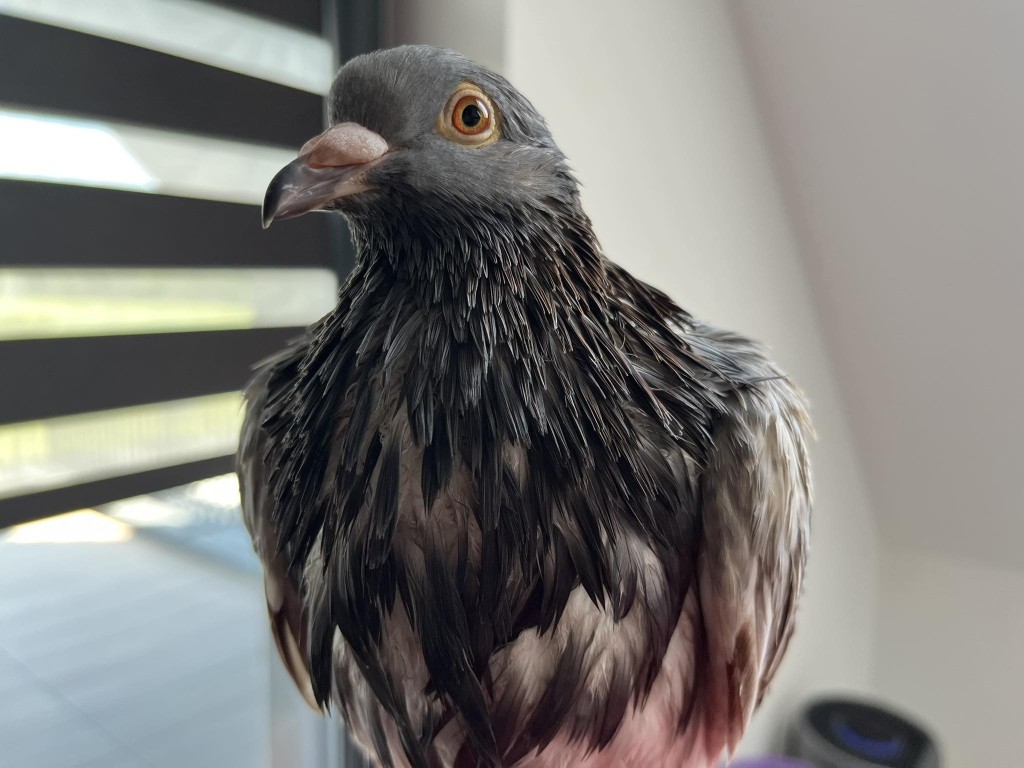
Protecting and Respecting Pigeons
Importance of Pigeons in Ecosystem
- Their Role in the Environment Pigeons do important jobs for our planet! By eating seeds and then flying around, they help plants by spreading their seeds to new places. This helps more plants to grow, creating lovely green spaces. And, they are a tasty meal for some predators, making them an important part of the food chain.
- Importance of Biodiversity Having many different kinds of plants and animals, like pigeons, makes the earth a rich and healthy place. Pigeons are a part of our world’s wonderful biodiversity, helping to keep our ecosystems lively and balanced by doing their part in nature’s big, interconnected family.
Challenges Faced by Pigeons
- Threats and Dangers to Pigeons Our feathery friends face several challenges. From natural predators like hawks to harsh weather conditions, life for a pigeon can be pretty tough at times. Navigating through these natural challenges requires agility and adaptability from these robust birds.
- Human-Created Challenges Sadly, pigeons also face problems created by us humans. Things like pollution, reduced natural spaces, and sometimes even harmful interactions with people can make their lives difficult. It’s crucial that we learn about these challenges to understand how we can make the world a friendlier place for pigeons.
How to Help and Protect Pigeons
- Responsible Feeding and Interaction When we meet pigeons, it’s vital to be kind and respectful. If you want to feed them, offer safe, pigeon-friendly snacks like peas or chopped veggies instead of processed human foods. And remember, a little goes a long way!
- Supporting Pigeon-Friendly Environments Creating and supporting spaces where pigeons can live happily is wonderful! Ensuring they have safe places to build their nests and access to clean water and natural food sources helps them to thrive. By being mindful of our actions and advocating for bird-friendly practices in our communities, we can help pigeons lead safer and happier lives.
Check my article about Facts About Pigeons
Our journey alongside pigeons shows us that every creature, no matter how common we think they are, plays a vital role in our world. By understanding, respecting, and protecting pigeons, we also contribute to maintaining the beautiful balance of our shared environment. Let’s carry these lessons in our hearts and continue to explore and cherish the wonderful world of pigeons and all the creatures with whom we share our planet.
What Does a Pigeon Look Like? Final Thoughts
Pigeons, with their gentle eyes and soft coos, are truly remarkable creatures that grace our world. These lovely birds, often spotted in our cities and parks, hide surprising wonders beneath their feathery wings. From being messengers in history to playing a crucial role in nature, they enrich our lives and ecosystems in subtle yet vital ways. Let’s appreciate the beauty and simplicity they bring to our everyday moments and ensure that we coexist harmoniously, safeguarding their existence for future generations. May we always find joy in their gentle presence and remember to tread kindly, respecting all beings that share our world.
What Does a Pigeon Look Like? FAQs
What is the most common color of a pigeon?
The most common color of a pigeon is grey, although they can be found in a range of colors and patterns.
How would you describe the size and shape of a pigeon?
Pigeons are generally medium-sized birds with a round body, short legs, and a small head.
Can pigeons have different patterns on their feathers?
Yes, pigeons can have various patterns on their feathers, including spots, stripes, and more, depending on the breed and type.
What does a pigeon’s beak look like?
A pigeon’s beak is relatively short and slightly curved downward. It’s strong and suitable for pecking at food.
How do pigeons’ eyes appear?
Pigeons typically have bright, round eyes that can be orange, red, or golden in color.
Are there pigeons with entirely white feathers?
Yes, some pigeons are entirely white, and they are often associated with peace and used in various ceremonies and events.
What is a noticeable feature of a pigeon’s neck?
Pigeons often have iridescent feathers on their neck, which can shimmer with green and purple hues in the sunlight.
Do all pigeons look the same regardless of their gender?
Pigeons generally have slight differences based on gender. Males might have brighter and more vivid neck colors, while females may have a more subdued appearance.
Can pigeons’ appearance change as they age?
Yes, pigeons’ appearance can change slightly as they age. Young pigeons, or squabs, usually have softer, duller plumage which becomes more defined and colorful as they mature.
Do pigeons have long or short tails?
Pigeons typically have relatively short tails, which fan out when they are in flight or trying to balance.

